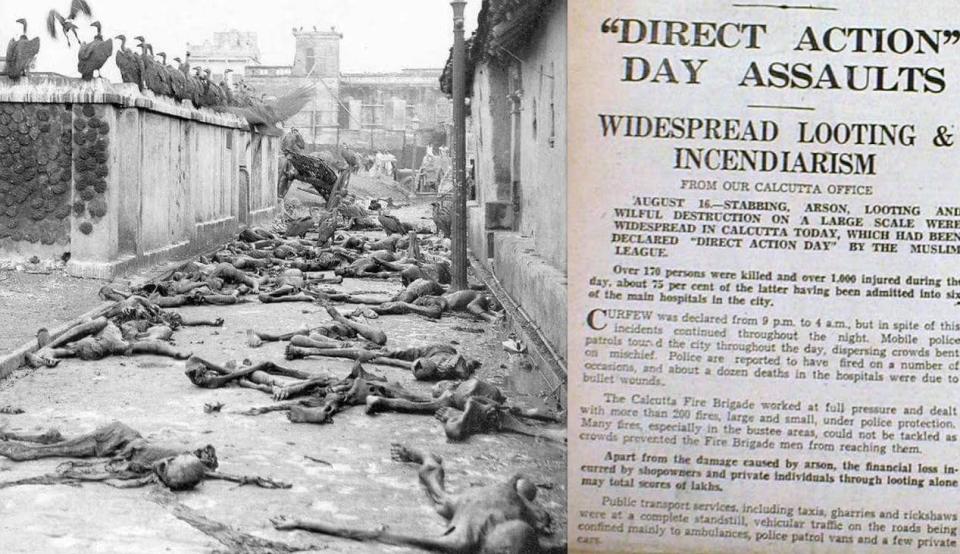Looking back at the blood-curdling Calcutta Killings of 16th August 1946

The history of India, at the hands of assorted historians, has always been subjected to nefarious distortions, at times to further a narrative of their liking, at times to white-wash monstrosities of the most barbarous forms. One such was the call for Direct Action Day, the gory Calcutta Killings, which was deliberately omitted from school syllabi.
The Indian independence movement had reached a critical juncture, and the British left depilated after the World War II had long realized that they had not many options but to leave India and were holding talks with the representatives of the Indian National Congress and the All India Muslim League to plan the transfer of power, the new Dominion of India and its government.
The Muslim league, led by ex-Congressman Muhammad Ali Jinnah, had placed their demand for a separate Islamic state that was to be formed by cutting out several provinces form the northwest and the east of undivided India. But Jinnah grew insecure in the later days fearing the Hindu domination may betray their plans of a separate state and announced August 16th, 1946 as ‘Direct Action Day’.
The league commenced a rally from the Shaheed Minar at 12 PM exactly; the gathering constituting of 30 thousand as per some and 50 thousand according to other reports, was the largest Muslim assembly to have ever held in Bengal. Reports suggest that Huseyn Shaheed Suhrawardy had already seen it that no police or military arrangements would interfere in what were to happen next.
The city of Calcutta witnessed an unrest never seen before, never to be experienced again. Shops were forced to shut down throughout as riots started to brawl up, stabbing, throwing of stones and brickbats spiraled across the City of Joy. The heavily concentrated thriving areas including Rajabazar, Colootolla, College Street, and Harrison Road were taken in target. Lorries arrived at Harrison road, attendees of the rally who were already instigated by the speeches of Khawaja Nazimuddin and Chief Minister Suhrawardy were unleashed on the roads of the city marking the beginning of the naked dance of death.
On the 17th, Syed Abdullah Farooqui, President of Garden Reach Textile Workers' Union, led a radical mob into the compound of Kesoram Cotton Mills in Metiabruz. The death toll of Oriya labors residing in the mills were reported to be 7000 to 10,000. Some suggest most of the victims were Muslims, and other authors claim that Hindu casualties surpassed the former. But a dead man has no religion, he is just a body stripped of life forcefully, brutally.
Lawlessness pervaded and expanded to other areas of the city. Hindus, Sikhs, Gorkhas, all were up in arms by the evening of the 17th. Flames of fire were gulping down the once British capital; markets, residential localities, slums - none was spared. Violence that found its inception in the Indians’ contest with the Europeans had turned into a bloody war pitting Indians against Indians, the massacre continued for days before the British military could bring it under control, but not before having claimed and changing numerous lives forever.
Howrah Bridge remained crowed for days with evacuees struggling to flee the mayhem. Only a few had the destiny to evade this bloodbath, which sparked Hindu/Sikh-Muslim riots in Noakhali, Bihar and Punjab in the months to come. Both British and Congress had their fingers pointed at Jinnah and his league for stirring the Islamic state sentiment at such a volatile moment and calling the Direct-Action Day.
But that is history, a history that generations of Indians should be introduced to, history that they were denied information of, history that had been purposely kept from the History books of most of the Central and State boards of education. Why was such an impactful incident, the blood-soaked day of 16th August 1946, one that maneuvered the partition of India, turned the city of Kolkata into a slaughter house leaving unnumbered people killed, homeless, raped and looted, was encouraged to be forgotten, is a question, we surmise, will stay unanswered forever.

 Yahoo Finance
Yahoo Finance 